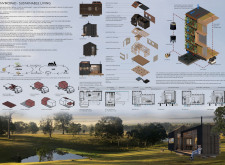5 key facts about this project
Functionally, the EnviroPad serves as a modular living unit that is adaptable to varying geographical contexts. It incorporates contemporary design strategies that facilitate a self-sufficient lifestyle. The architecture promotes the efficient use of resources and aims to minimize the ecological footprint of its residents. By integrating renewable energy sources and innovative agricultural practices, such as aquaponics, the project fosters an environment where inhabitants can thrive while embracing sustainability.
A defining feature of the project is its modular design, which not only supports ease of transport and installation but also allows for flexibility in different environments. By using modified shipping containers as the core structure, the design emphasizes a resourceful approach to construction, maximizing the utility of materials that are often overlooked. This choice enhances the project’s sustainability credentials while also appealing to a growing trend in architecture that values reusability.
The design details of the EnviroPad are meticulously considered. The layout includes integrated living spaces that balance communal areas with private zones, facilitating social interaction while maintaining individual privacy. The arrangement of spaces is a testament to thorough planning, accommodating the functional needs of daily life while promoting a connection to nature. Large windows and open balconies allow for natural light and ventilation, further reducing reliance on mechanical systems and creating a pleasant living atmosphere.
Moreover, the inclusion of an aquaponics system within the residential structure is particularly noteworthy. By harnessing nutrients from fish waste, it supports sustainable gardening practices, enabling residents to grow food within their living environment. This not only contributes to food security but also educates inhabitants on ecological stewardship. Such features exemplify the project’s commitment to integrating architecture with sustainable practices.
Materials play a crucial role in the overall integrity of the EnviroPad. The selection of wood for structural elements and finishes reflects an adherence to sustainability, ensuring that each component contributes positively to the environment. Additionally, the use of photovoltaic panels exemplifies the forward-thinking approach to energy consumption, allowing the residential unit to generate its own power.
The EnviroPad project stands out due to its emphasis on a holistic living experience. The design not only addresses the immediate needs of its occupants but also considers the long-term implications for environmental sustainability. By embedding principles that advocate for circular economies and minimal waste, the project illustrates a comprehensive understanding of contemporary architectural challenges.
Through a combination of unique design approaches, such as modular construction and innovative systems for food production, the EnviroPad advances the discourse around sustainable architecture. This project is not merely a shelter but a representation of the potential for architecture to adapt and respond to environmental imperatives while enhancing human well-being.
For those interested in exploring the EnviroPad project further, a review of the architectural plans, architectural sections, and specific architectural ideas will provide deeper insights into the design strategies and thought processes behind this innovative endeavor. Delve into the project presentation to appreciate the nuanced details and holistic vision that define this sustainable living model.























